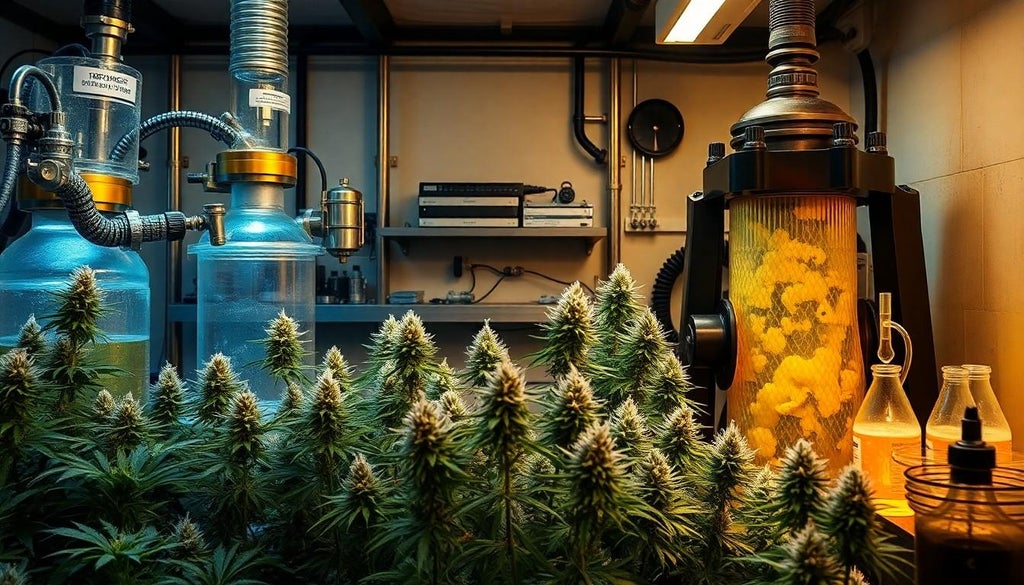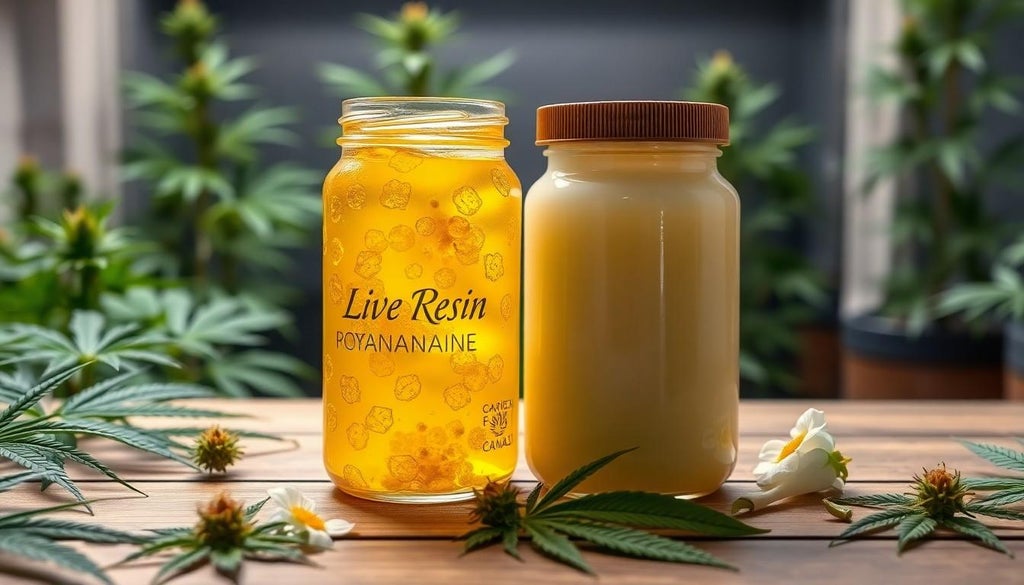Blog
Live Resin vs Live Rosin: Ultimate Cannabis Concentrate Showdown
Cannabis concentrates have revolutionized the way enthusiasts experience their favorite plant. As the market continues to evolve, two standout extracts have captured the attention of consumers and connoisseurs alike: live resin and live rosin. While they might sound similar, these concentrates represent distinct extraction methods that significantly impact flavor potency and overall experience.
Key Takeaways
- Live resin and live rosin are premium cannabis concentrates with distinct extraction methods, with live resin using hydrocarbon solvents and live rosin utilizing a solventless mechanical pressing technique.
- Terpene preservation is crucial in both concentrates, with live resin capturing approximately 90-95% and live rosin preserving 80-85% of the original plant’s terpene profile, ensuring rich flavor and aromatic complexity.
- Potency levels differ slightly between the two extracts, with live resin typically ranging 60-80% total cannabinoid content (70-75% THC) and live rosin showing 55-75% total cannabinoids (65-70% THC).
- Live rosin offers a purer extraction method with zero solvent residue, making it a cleaner option for health-conscious consumers who prefer a more natural cannabis concentrate.
- Cost and accessibility vary significantly, with live rosin commanding higher prices ($50-$80 per gram) due to labor-intensive production, while live resin remains more affordable ($30-$60 per gram) and widely available.
- Consumption methods for both concentrates include dabbing, vaporization, and supplemental flower usage, with optimal temperatures ranging between 315-465°F to preserve terpene profiles and maximize cannabinoid absorption.
We’ll dive deep into the key differences between live resin and live rosin, exploring how each extraction technique preserves the plant’s unique cannabinoid and terpene profiles. Understanding these nuanced concentrates can help consumers make more informed choices about their cannabis consumption. From extraction processes to flavor profiles and potency, these two extracts offer unique characteristics that set them apart in the competitive world of cannabis concentrates.
What Are Live Resin and Live Rosin?
Live resin and live rosin represent two premium cannabis concentrates crafted through specialized extraction techniques. These concentrates capture the plant’s most delicate cannabinoid and terpene profiles, delivering intense flavor and potent experiences for cannabis enthusiasts.
Key Differences in Production
Live resin extraction involves flash-freezing fresh cannabis plants immediately after harvest and using hydrocarbon solvents like butane or propane to extract cannabinoids. This method preserves the plant’s original terpene structure, resulting in a more flavorful concentrate with complex aromatic profiles.
Live rosin production differs significantly by using a solventless extraction method. Processors first create ice water hash from freshly frozen cannabis plants, then apply heat and extreme pressure to squeeze out concentrated oils. This technique eliminates chemical solvents, producing a pure extract that maintains the plant’s natural essence.
Botanical Origins
Cannabis concentrates originate from carefully selected plant cultivars with specific genetic characteristics. Live resin and live rosin typically start with high-terpene, high-cannabinoid strains selected for their unique flavor profiles and potency potential.
The selection process involves identifying cannabis cultivars with:
- Robust terpene profiles
- High cannabinoid percentages
- Consistent genetic expressions
- Optimal growing conditions
Each extraction method transforms these carefully chosen botanical sources into distinct concentrates that highlight the plant’s inherent chemical complexity.
Extraction Methods

Extraction methods play a crucial role in defining the unique characteristics of live resin and live rosin. These techniques determine the final product’s purity, flavor profile, and overall cannabis experience.
Solvent-Based Extraction for Live Resin

Lucky Extracts live resin extraction involves complex hydrocarbon solvent techniques that preserve cannabis’s original terpene profile. Processors use specialized equipment to flash-freeze freshly harvested cannabis plants immediately after cutting. Butane or propane serve as primary solvents that strip cannabinoids and terpenes from frozen plant material.
Key steps in live resin extraction include:
- Rapid freezing of fresh cannabis plants at -40°F to -50°F
- Passing cold hydrocarbon solvents through frozen plant material
- Extracting cannabinoid and terpene compounds
- Purging residual solvents through precise temperature and pressure control
- Filtering the extract to remove plant particulates
Advanced extraction systems maintain temperatures between -20°F and 0°F during processing. This ultra-cold approach ensures maximum terpene preservation and minimal degradation of sensitive cannabis compounds.
Solventless Extraction for Live Rosin

Live rosin extraction represents a pure mechanical separation process without chemical solvents. The method focuses on mechanical pressure and temperature to extract cannabis oils from specially prepared hash.
Primary extraction steps include:
- Harvesting fresh cannabis plants at peak maturity
- Creating ice water hash through gentle agitation
- Collecting and freeze-drying isolated trichome heads
- Applying precise heat and pressure to compressed hash
- Collecting pure rosin extract through mechanical pressing
- Temperatures between 160°F and 220°F
- Pressures ranging from 300 to 1000 pounds per square inch
- Minimal processing time to retain volatile terpene compounds
Potency and Cannabinoid Profile

Live resin and live rosin represent two distinct cannabis concentrates with unique potency characteristics. Their extraction methods directly impact the final cannabinoid and terpene profiles, creating significant differences in overall consumer experience.
Terpene Preservation
Terpene preservation defines the core quality of live extracts. Live resin captures approximately 90-95% of the original plant’s terpene profile through rapid freezing and hydrocarbon extraction. Conversely, live rosin preserves 80-85% of original terpenes using mechanical separation techniques. The solventless nature of live rosin ensures minimal chemical interaction, maintaining a more natural terpene spectrum.
Key terpene preservation factors include:
- Harvest timing
- Freezing temperature (0-5°F)
- Extraction method
- Processing duration
Cannabinoid Concentration Levels
Cannabinoid concentration varies between live resin and live rosin. Live resin typically ranges from 60-80% total cannabinoid content, with THC levels averaging 70-75%. Live rosin demonstrates slightly lower concentrations, ranging from 55-75% total cannabinoids, with THC levels around 65-70%.
| Concentrate Type | Total Cannabinoids | THC Range | CBD Range |
|---|---|---|---|
| Live Resin | 60-80% | 70-75% | 0-5% |
| Live Rosin | 55-75% | 65-70% | 0-5% |
Quality and Purity Considerations
The quality and purity of cannabis concentrates play a critical role in consumer experience and safety. Our analysis explores the nuanced aspects of live resin and live rosin that impact their overall quality and potential health implications.
Potential Health Implications
Cannabis concentrate purity directly influences user safety and therapeutic potential. Live rosin emerges as the cleaner option due to its solventless extraction process. Key health considerations include:
- Chemical residue potential: Live resin may contain trace hydrocarbon solvents
- Terpene preservation: Both concentrates maintain high terpene profiles supporting entourage effects
- Contaminant risk: Solventless methods reduce potential chemical exposure
- Cannabinoid integrity: Extraction methods impact molecular stability of active compounds
Extraction Safety Standards
Safety standards for cannabis concentrates involve rigorous testing and regulatory compliance. Our examination reveals critical quality control measures:
| Safety Parameter | Live Resin | Live Rosin |
|---|---|---|
| Solvent Testing | Required | Not Applicable |
| Microbial Screening | Mandatory | Mandatory |
| Heavy Metal Analysis | Comprehensive | Comprehensive |
| Residual Solvent Limits | <500 ppm | Zero ppm |
Professional extraction facilities must adhere to state-mandated testing protocols. Accredited laboratories analyze concentrates for:
- Pesticide residues
- Microbial contamination
- Cannabinoid potency
- Terpene profile consistency
Consumers should prioritize products from licensed manufacturers demonstrating transparent quality assurance processes.
Cost and Accessibility
The cost and market availability of live resin and live rosin significantly impact consumer choices in cannabis concentrates. These factors determine the accessibility and overall value proposition for cannabis enthusiasts seeking premium extracts.
Price Comparison
Live rosin commands a higher price point due to its labor-intensive solventless extraction process. Market prices typically range from $50-$80 per gram, compared to live resin’s more affordable $30-$60 per gram range. Production complexity drives the price difference:
| Concentrate Type | Average Price Range | Production Factors |
|---|---|---|
| Live Rosin | $50-$80/gram | Hand-pressed, no solvents, small batches |
| Live Resin | $30-$60/gram | Solvent-based extraction, larger volumes |
Key price determinants include:
- Extraction method complexity
- Raw material quality
- Production volume
- Terpene and cannabinoid concentration
Market Availability
Live resin enjoys broader market penetration across cannabis dispensaries nationwide. Its more scalable production process enables wider distribution through licensed retailers like Get Cannabis Online. Live rosin remains a boutique product with:
- Limited regional availability
- Smaller production runs
- Higher demand from connoisseur markets
- Specialized cultivation requirements
Consumers searching on Get Cannabis Online can expect more consistent live resin inventory with occasional live rosin selections from premium brands.
Consumption Methods
Live resin and live rosin offer unique consumption experiences that cater to different preferences and equipment. Understanding the appropriate techniques maximizes the potency and flavor of these premium cannabis concentrates.
Recommended Usage Techniques
We recommend several precise consumption methods for both live resin and live rosin:
- Dabbing
- Optimal temperature range: 315-465°F
- Best for preserving terpene profiles
- Requires specialized dab rig with quartz or titanium nail
- Provides immediate cannabinoid absorption
- Vaporization
- Use low-temperature electronic devices
- Ceramic or quartz heating chambers preferred
- Temperature control critical for terpene preservation
- Portable live resin vape pens designed for concentrates work best
- Supplemental Flower Consumption
- Sprinkle small amounts on cannabis flower
- Enhanced potency and flavor profile
- Recommended for experienced consumers
- Use glass pipe or water bong for smooth delivery
Compatibility with Different Devices
We analyze concentrate compatibility across various consumption platforms:
| Device Type | Live Resin | Live Rosin | Recommended Temperature |
|---|---|---|---|
| Dab Rigs | High compatibility | High compatibility | 350-425°F |
| Portable Vaporizers | Moderate | High | 315-400°F |
| Desktop Vaporizers | High | High | 325-450°F |
| E-Rigs | Excellent | Excellent | 300-380°F |
- Viscosity of concentrate
- Heating element material
- Temperature precision
- Portability requirements
Conclusion
Whether you’re a cannabis enthusiast or a curious consumer, live resin and live rosin offer unique experiences that cater to different preferences. We’ve explored their distinctive extraction methods terpene profiles and overall consumption characteristics.
The choice between live resin and live rosin ultimately depends on personal priorities. Some users might prioritize affordability and broader availability while others may seek the purest solventless extraction method. Our recommendation is to experiment responsibly and find the concentrate that best suits your individual needs and desired cannabis experience.
As the cannabis concentrate market continues evolving we can expect even more refined techniques and innovative products that push the boundaries of extraction technology and consumer enjoyment.
Frequently Asked Questions
What is the main difference between live resin and live rosin?
Live resin is extracted using hydrocarbon solvents and flash-freezing techniques, while live rosin is created through a solventless method using ice water hash and mechanical pressing. Live resin preserves around 90-95% of plant terpenes, and live rosin preserves 80-85%, with subtle variations in flavor, potency, and extraction processes.
How is live resin extracted?
Live resin extraction involves harvesting fresh cannabis plants and immediately flash-freezing them to preserve terpene profiles. Cold hydrocarbon solvents are then passed through the frozen plant material to extract cannabinoids and terpenes. After extraction, the solvent is purged, leaving behind a concentrated, flavorful extract with high terpene retention.
What makes live rosin a cleaner concentrate?
Live rosin is considered cleaner because it’s produced without chemical solvents. The extraction process uses only water, ice, and mechanical pressure to separate trichomes and collect essential oils. This solventless method eliminates potential chemical residue risks, making it a preferred choice for health-conscious consumers seeking a pure, unadulterated cannabis concentrate.
What are the typical cannabinoid concentrations in live resin and live rosin?
Live resin typically contains 60-80% total cannabinoids, with THC levels averaging 70-75%. Live rosin has slightly lower concentrations, ranging from 55-75% total cannabinoids and THC levels around 65-70%. These variations depend on factors like strain selection, harvest timing, and extraction techniques.
How much do live resin and live rosin cost?
Live resin is more affordable, priced between $30-$60 per gram, due to its scalable production process. Live rosin is more expensive, ranging from $50-$80 per gram, reflecting its labor-intensive, solventless extraction method and boutique status in the cannabis market.
What is the best consumption method for these concentrates?
Dabbing is the most recommended method, with an optimal temperature range of 315-465°F. Low-temperature electronic vaporizers are also ideal for preserving flavor and potency. Experienced users might combine these concentrates with flower for enhanced effects. Always use specialized equipment for safe and efficient consumption.
Are live resin and live rosin safe to consume?
Both concentrates undergo rigorous testing for safety. Live resin requires solvent residue testing, while live rosin bypasses this due to its solventless nature. Both are tested for microbial contamination and heavy metals. Consumers should purchase from licensed manufacturers with transparent quality assurance processes.
Which concentrate is better for flavor preservation?
Live resin is renowned for its exceptional flavor preservation, capturing up to 95% of the original plant’s terpene profile. Live rosin also maintains excellent flavor, preserving around 80-85% of terpenes. The choice depends on individual preferences and the specific strain’s characteristics.

